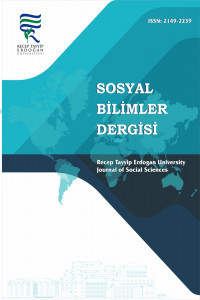THE RELATION BETWEEN ENVIRONMENTAL CHANGE AND ENVIRONMENTAL REFUGEES: THE CASE OF ASIA
Asya, Göç, İklim Mültecileri, Çevresel Değişim
THE RELATION BETWEEN ENVIRONMENTAL CHANGE AND ENVIRONMENTAL REFUGEES: THE CASE OF ASIA
Asia, Emigration, Environmental Refugees, Environmental Change,
___
- Badjeck, M. C., Allison, E. H., Halls, A. S., & Dulvy, N. K. (2010). Impacts of climate variability and change on fishery-based livelihoods. Marine policy, 34(3), 375-383.
- Bates, D. C. (2002). Environmental refugees? Classifying human migrations caused by environmental change. Population and environment, 23(5), 465-477.
- Bilici, İ. (2017). The effect of environmental change on human migration in the context of Asia [Conference presentation abstract]. XIV. European Conference on Social and Behavioral Sciences, Odesa, Ukraine.
- Black, R., Adger, W. N., Arnell, N. W., Dercon, S., Geddes, A., & Thomas, D. (2011). The effect of environmental change on human migration. Global environmental change, 21, 3-11.
- Castles, S. (2002). Environmental change and forced migration: making sense of the debate. Retrieved from http://www.unhcr.org/3de344fd9.html
- Geddes, A., Adger, W.N., Arnell, N.W., Black, R., Thomas D.S.G. (2012). Migration, Environmental Change, and the Challenges of Governance. Environmental and Planning C: Government and Policy, 30(6), 951-967.
- Heinonen, M. (2013). Migration and the false promise of growth. On The Horizon-The Strategic Planning Resource for Education Professionals, 21(3), 197-208.
- Hugo, G. (1996). Environmental concerns and international migration. International migration review, 30(1), 105-131.
- Islam, M. (1992). Natural calamities and environmental refugees in Bangladesh. Refuge: Canada's Journal on Refugees, 5-10.
- Keane, D. (2003). The environmental causes and consequences of migration: a search for the meaning of environmental refugees. Georgetown International Environmental Law Review, 16, 209-223.
- Massey, D. S., Axinn, W. G., & Ghimire, D. J. (2010). Environmental change and out-migration: Evidence from Nepal. Population and environment, 32(2-3), 109-136.
- McLeman, R. A. (2011). Settlement abandonment in the context of global environmental change. Global Environmental Change, 21, 108-120.
- Myers, N. (1993). Environmental refugees in a globally warmed world. Bioscience, 43(11), 752-761.
- Myers, N. (1997). Environmental refugees. Population and environment, 19(2), 167-182.
- Myers, N. (2002). Environmental refugees: a growing phenomenon of the 21st century. Philosophical Transactions of the Royal Society of London. Series B: Biological Sciences, 357(1420), 609-613.
- Refugees (n.d). Retrieved from: http://www.unhcr.org/pages/49c3646c125.html
- Suhrke, A. (1994). Environmental Degradation and Population Flows. Journal of International Affairs, 47(2), 473-496.
- Waldinger, M. (2015). The effects of climate change on internal and international migration: implications for developing countries. Retrieved from http://www.lse.ac.uk/GranthamInstitute/wp- content/uploads/2015/05/Working-Paper-192-Waldinger.pdf
- Warner, K., Hamza, M., Oliver-Smith, A., Renauld, F., & Julca, A. (2009). Climate change, environmental degradation and migration. Natural Hazards, 5(3), 689-715.
- Westing, A. H. (1992). Environmental refugees: a growing category of displaced persons. Environmental Conservation, 19(3), 201-207.
- ISSN: 2149-2239
- Yayın Aralığı: Yılda 2 Sayı
- Başlangıç: 2015
- Yayıncı: Recep Tayyip Erdoğan Üniversitesi
TÜRKİYE’DE DEMOKRATİK KÜLTÜR: TESPİTLER, ELEŞTİRİLER, TARTIŞMALAR
İsmail DURSUNOĞLU, Ferdi KATILMIŞ
HİRA MAĞARASI'NI AYDINLATAN NUR
THE RELATION BETWEEN ENVIRONMENTAL CHANGE AND ENVIRONMENTAL REFUGEES: THE CASE OF ASIA
